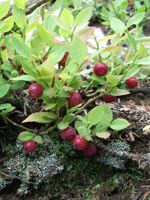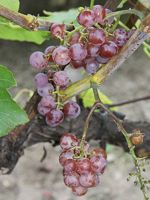Mon-Fri 9am - 5pm Mountain time
Somerset Grape vs Grouseberry
Vaccinium scoparium
Vitis Somerset
CUSTOM GROW
Grouseberry is a native, low-growing deciduous shrub known for its edible red berries. In early summer, it produces small, urn-shaped flowers ranging from white to pink that attract bees and other pollinators. The berries provide an important food source for many types of wildlife, including game birds such as grouse, which gives the plant its common name. People can also enjoy the berries fresh or in baked goods, though they can be difficult to harvest in large quantities.
Spreading by rhizomes, Grouseberry forms dense, broom-like mats that help stabilize soil and prevent erosion, while also providing cover for ground-nesting wildlife. It is commonly found beneath conifers in open forests, subalpine meadows, and occasionally on rocky slopes in mountainous regions. It is well-suited for naturalization, ecological restoration, and soil stabilization projects.
The Somerset Grape is a cold-hardy variety that is sweet, with a hint of a strawberry taste and tender skin, making them excellent for fresh eating. The grapes grow throughout the summer and go from a light pink and deepen in color as they ripen. The grapes will be at their peak sweetness in mid to late September, making that the best time for harvest.
The Somerset Grape is considered a seedless variety. Occasionally the fruit will contain seeds, but they are soft and barely noticeable. The grapes themselves are a bit smaller than the average size you’d find in the grocery store, however the cluster is compact and quite big. This vine is best supported with a trellis.
Note: We do not ship grape vines to BC due to regulatory restrictions from the Canadian Food Inspection Agency.

